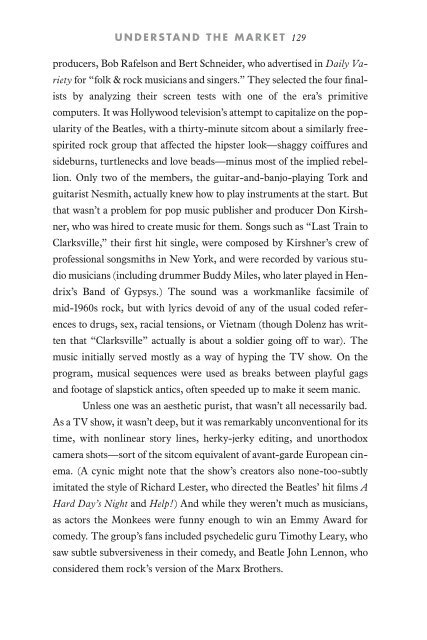the abbreviated reign of “neon” leon spinks
the abbreviated reign of “neon” leon spinks
the abbreviated reign of “neon” leon spinks
Create successful ePaper yourself
Turn your PDF publications into a flip-book with our unique Google optimized e-Paper software.
UNDERSTAND THE MARKET 129<br />
producers, Bob Rafelson and Bert Schneider, who advertised in Daily Va-<br />
riety for “folk & rock musicians and singers.” They selected <strong>the</strong> four fi nal-<br />
ists by analyzing <strong>the</strong>ir screen tests with one <strong>of</strong> <strong>the</strong> era’s primitive<br />
computers. It was Hollywood television’s attempt to capitalize on <strong>the</strong> popularity<br />
<strong>of</strong> <strong>the</strong> Beatles, with a thirty-minute sitcom about a similarly freespirited<br />
rock group that affected <strong>the</strong> hipster look—shaggy coiffures and<br />
sideburns, turtlenecks and love beads—minus most <strong>of</strong> <strong>the</strong> implied rebellion.<br />
Only two <strong>of</strong> <strong>the</strong> members, <strong>the</strong> guitar-and-banjo-playing Tork and<br />
guitarist Nesmith, actually knew how to play instruments at <strong>the</strong> start. But<br />
that wasn’t a problem for pop music publisher and producer Don Kirshner,<br />
who was hired to create music for <strong>the</strong>m. Songs such as “Last Train to<br />
Clarksville,” <strong>the</strong>ir first hit single, were composed by Kirshner’s crew <strong>of</strong><br />
pr<strong>of</strong>essional songsmiths in New York, and were recorded by various studio<br />
musicians (including drummer Buddy Miles, who later played in Hendrix’s<br />
Band <strong>of</strong> Gypsys.) The sound was a workmanlike facsimile <strong>of</strong><br />
mid-1960s rock, but with lyrics devoid <strong>of</strong> any <strong>of</strong> <strong>the</strong> usual coded references<br />
to drugs, sex, racial tensions, or Vietnam (though Dolenz has written<br />
that “Clarksville” actually is about a soldier going <strong>of</strong>f to war). The<br />
music initially served mostly as a way <strong>of</strong> hyping <strong>the</strong> TV show. On <strong>the</strong><br />
program, musical sequences were used as breaks between playful gags<br />
and footage <strong>of</strong> slapstick antics, <strong>of</strong>ten speeded up to make it seem manic.<br />
Unless one was an aes<strong>the</strong>tic purist, that wasn’t all necessarily bad.<br />
As a TV show, it wasn’t deep, but it was remarkably unconventional for its<br />
time, with nonlinear story lines, herky-jerky editing, and unorthodox<br />
camera shots—sort <strong>of</strong> <strong>the</strong> sitcom equivalent <strong>of</strong> avant-garde European cinema.<br />
(A cynic might note that <strong>the</strong> show’s creators also none-too-subtly<br />
imitated <strong>the</strong> style <strong>of</strong> Richard Lester, who directed <strong>the</strong> Beatles’ hit fi lms A<br />
Hard Day’s Night and Help!) And while <strong>the</strong>y weren’t much as musicians,<br />
as actors <strong>the</strong> Monkees were funny enough to win an Emmy Award for<br />
comedy. The group’s fans included psychedelic guru Timothy Leary, who<br />
saw subtle subversiveness in <strong>the</strong>ir comedy, and Beatle John Lennon, who<br />
considered <strong>the</strong>m rock’s version <strong>of</strong> <strong>the</strong> Marx Bro<strong>the</strong>rs.



